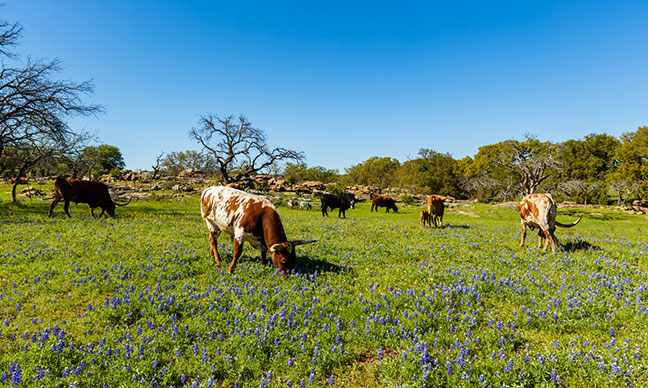Trees benefit us in many ways – they provide shade, food, and shelter, reduce runoff, purify the air, and conserve water and energy. They also enhance the appearance of our landscapes. Planting the right ones at the right places ensures that you enjoy all of these perks for years to come.
If you are looking for native trees to spruce up your Texas home, the list can be expansive depending on what you are looking for and hope to achieve; is it shade? Blossoms? Fall colors?
We have compiled a list of Texas native trees to help you identify those that serve your desired purpose the best with little maintenance.
Related Post: Best Time To Plant Trees In Texas
Texas Native Trees: 8 Easy-To-Plant Species That Will Do Well Anywhere
If you just moved to the Lone Star State and looking to add some greenery to your property, you may want to know, “What is the most common tree in Texas?” Well, there is a host of trees that grow well in Texas with little to no maintenance. The most common include:
1. Southern Red Oak
Looking for a tree that will give you massive shade with little maintenance? The Southern Red Oak could be just what you need. It is fast-growing, long-lasting, and incredibly hardy, which makes it one of the most popular shade trees in Texas.
Sited right, this tree will max out to a height of 80 feet and spread up to 50 feet wide. It prefers full sun and will thrive best in hot, humid environments. It is also extremely drought and wind tolerant. The acorns produced by the tree provide food for a wide range of wildlife and come fall, the tree graces your yard with stunning red and yellow foliage.
2. Cedar Elm
Second in popularity is the Cedar Elm, another one of our favorite Texas native trees. You can tell it from other elm species by its smaller foliage and thicker cuticles, which helps it withstand the hot dry climate of Texas. This unique feature also makes Cedar Elms some of the most prominent trees in West Texas.
When conditions are right, these trees will grow up to 70 feet high, 60 feet wide, and live up to 100 years. They will tolerate a wide range of soil types, urban air pollution, and other issues affecting tree growth in Texas.
However, the Dutch elm disease is still a serious problem in Texas, so you may want to have your elms checked once in a while by a tree service Texas expert. But this extra little work is nothing compared to the life and vibrancy these trees add to your yard, especially in the fall when their leaves turn golden yellow.
3. Eastern Redbud
Famed for its vibrant blankets of pink blossoms that welcome the warmer season, the Eastern Redbud marks the end of the cold winter and the beginning of warmer months. It is always among the first trees to produce flowers every year and because the blooms grow on old wood, it offers the much-needed breath of fresh air after the long cold winter season.
This tree prefers well-drained soils and when conditions right, it can grow up to 30 feet in height and 15 feet in width though most of the time it reaches about 20 feet high and 10 feet wide. It is, therefore, one of the best flowering trees in Texas for people with small yard spaces. And don’t be fooled by its delicate appearance; this tree is incredibly strong. It is adaptable to most soil types and tolerable to the hot Texas weather.
Related Post: Small Trees In Texas
4. Pecan
A big yard is all you need to grow a pecan tree that will ensure you and your family enjoy a pecan pie for years to come! And if you are wondering, “Are pecan trees native to Texas?” yes they are. Pecan trees are native to around 140 counties in Texas but can grow and produce in every part of Texas.
Related Post: Texas State Tree
These trees will take between 20 and 25 years to reach a mature height of 100 feet and a width of 50 feet. But do not lose hope yet; a pecan tree will start producing nuts in as little as 3 to 7 years. A mature pecan tree will have a massive trunk and a huge root system that runs wide and deep. Plant in a spot with full sun, well-drained soils, and sufficient room, and away from buildings or plants that could be broken or damaged by falling limbs.
Related Posts: Types Of Pecans In Texas & Pecan Tree Diseases
5. Live Oak
Another one of our favorite native Texas trees for people with larger yard spaces is the Live Oak. This tree is not only a picturesque addition to your property but also grows fast than most oak varieties to serve you with shade for many years. Due to their ability to adapt to many soil types and resist most of the common tree diseases in Texas, live oaks can be used in parks, as street trees, and for commercial and residential landscaping.
These trees will grow to about 50 feet high, with a spread of about 100 feet, keeping the landscape vibrant with massive shade and deep green foliage all year round. While they prefer well-drained soils, they can adapt to a wide variety of soil types. Live oaks are also extremely drought, wind, and heat tolerant, and will thrive in severe conditions with little maintenance.
Related Post: Oak Trees In Texas
6. Texas Ash
If your yard is not big enough to accommodate a Southern Red Oak or Cedar Elm, go for a smaller tree, and a Texas Ash, in this case, would be a great option. This small beauty that grows only 40 feet high is the most common tree in Texas and for a good reason; it is fast-growing, extremely drought tolerant, and will keep your yard vibrant with little care.
The leaves maintain a deep green color up until fall when they turn into beautiful shades of orange, yellow, purple, maroon, and red. Younger Ash trees exhibit smooth, light gray barks and as the trees mature, they appear dark gray with light fissures.
The only downside of Texas Ash trees is that they are susceptible to the Emerald Ash Borer, a deadly insect that has been wreaking havoc on ash trees for many years. But this can easily be managed by regularly using pesticides on your trees and making sure they are in tiptop condition.
Related Posts: Texas Ash Tree & Texas Tree Bugs
7. Southern Magnolia
The Southern Magnolia is not only an iconic ornamental tree but also a privacy tree than has been grown in Texas for years. You can count on it to serve your desired purpose for generations especially because it is native to this state.
Planted at the right spot, that is, in well-drained soils that receive full sunlight, a Southern Magnolia tree will grow to a height of 80 feet, with its canopy spreading up to 40 feet wide. It will grace your property with rich color when most of the trees go dormant, providing a great place for birds, rabbits, and squirrels to hide. And don’t forget its notable fragrant creamy-white flowers that will keep your space livened up and busy with nectar-sucking wildlife all spring long!
8. Weeping Willow
Texans love the Weeping Willow for its dramatic, yet stunning rounded, weeping shape. If you are looking for a classic look that adds value to your property, this tree would be a great addition to your property. It is the most common tree in Texas, all thanks to its stunning appearance and ability to withstand a host of harsh soil and climatic conditions.
Taken good care of, a Weeping Willow usually maxes out to a height of 50 feet and spreads to about 40 feet. It ranks among the fastest-growing shade trees, increasing up to 8 feet in height every year. While it starts out thin with just a few branches pointing upward against the stem, once it reaches the height of 10 feet, the tree produces more and more branches that curve outward, creating the weeping canopy that gives it its name.
What Trees Are Native To North Texas?
The most common trees in North Texas include:
- Shumard red oaks
- Autumn blaze oaks
- Cedar elms
- Pecans
- Bur oaks
- Live oaks
- Mountain laurel
- Monterrey oaks
- Yaupons
The Local Tree Experts Overview
Trees are a great investment. If you are looking for the best varieties to revamp your Texas property, native species would be an excellent choice. Hopefully, our list of Texas native trees will help you pick the varieties that best meet your needs. We have rounded up the easiest to plant and maintain to make your landscaping undertakings effortless. If you, however, aren’t sure which trees would grow best in your area, consult an expert arborist. They should be able to guide you based on what you hope to achieve, your soil type, the size of your yard, and such things that could affect the growth of your trees.




